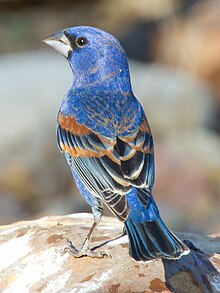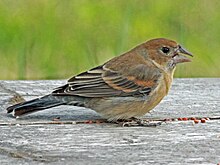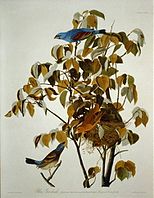Blue grosbeak
| Blue grosbeak | |
|---|---|

| |
| Adult male | |

| |
| Adult female | |
| Scientific classification | |
| Domain: | Eukaryota |
| Kingdom: | Animalia |
| Phylum: | Chordata |
| Class: | Aves |
| Order: | Passeriformes |
| Family: | Cardinalidae |
| Genus: | Passerina |
| Species: | P. caerulea
|
| Binomial name | |
| Passerina caerulea | |

| |
| Synonyms | |
| |
The blue grosbeak (Passerina caerulea), is a medium-sized seed-eating bird in the same family as the northern cardinal, "tropical" or New World buntings, and "cardinal-grosbeaks" or New World grosbeaks.
Taxonomy
The blue grosbeak was formally described by the Swedish naturalist Carl Linnaeus in 1758 in the tenth edition of his Systema Naturae under the binomial name Loxia caerulea.[2] The specific epithet caerulea is the Latin word for "blue", "azure-blue", "sky-blue" or "dark-blue".[3] Linnaeus based his own description on the "blew gross-beak" described and illustrated by Mark Catesby in his "The Natural History of Carolina, Florida and the Bahama Islands". Catesby's book had been published in 1729-1732.[4] Catesby gave the location as Carolina and Linnaeus specified America. The type location is now restricted to South Carolina.[5] The blue grosbeak is placed in the genus Passerina that was introduced by the French ornithologist Louis Jean Pierre Vieillot in 1816.[6][7]
Seven subspecies are recognised:[7]
- P. c. caerulea (Linnaeus, 1758) – southeast and south central USA
- P. c. interfusa (Dwight & Griscom, 1927) – west central USA and north Mexico
- P. c. salicaria (Grinnell, 1911) – southwest USA and northwest Mexico
- P. c. eurhyncha (Coues, 1874) – central and south Mexico
- P. c. chiapensis (Nelson, 1898) – south Mexico to Guatemala
- P. c. deltarhyncha (Van Rossem, 1938) – west Mexico
- P. c. lazula (Lesson, R, 1842) – south Guatemala to northwest Costa Rica
Description
The male blue grosbeak is deep blue, with both black and brown on its wings. The female is mostly brown. Both sexes are distinguished by their large, deep bill and double wing bars. These features, as well as the grosbeak's relatively larger size, distinguish this species from the indigo bunting. Length can range from 14 to 19 cm (5.5 to 7.5 in) and wingspan is from 26 to 29 cm (10 to 11 in).[8][9] Body mass is typically from 26 to 31.5 g (0.92 to 1.11 oz).[10]
Distribution and habitat
This is a migratory bird, with nesting grounds across most of the southern half of the United States and much of northern Mexico, migrating south to Central America and in very small numbers to northern South America; the southernmost record comes from eastern Ecuador. It eats mostly insects, but it will also eat snails, spiders, seeds, grains, and wild fruits. The blue grosbeak forages on the ground and in shrubs and trees.
This species is found in partly open habitat with scattered trees, riparian woodland, scrub, thickets, cultivated lands, woodland edges, overgrown fields, or hedgerows. It nests in a low tree or bush or a tangle of vegetation, usually about 1–3 m (3.3–9.8 ft) above ground, often at the edge of an open area.
- Gallery
-
Male (upper), female (lower)
-
Blue Grosbeak in Birds of America
References
- ^ BirdLife International (2012). "Passerina caerulea". IUCN Red List of Threatened Species. 2012. Retrieved 26 November 2013.
{{cite journal}}: Invalid|ref=harv(help) - ^ Linnaeus, Carl (1758). Systema Naturae per regna tria naturae, secundum classes, ordines, genera, species, cum characteribus, differentiis, synonymis, locis (in Latin). Vol. Volume 1 (10th ed.). Holmiae (Stockholm): Laurentii Salvii. p. 1175.
{{cite book}}:|volume=has extra text (help) - ^ Jobling, James A. (2010). The Helm Dictionary of Scientific Bird Names. London: Christopher Helm. p. 82. ISBN 978-1-4081-2501-4.
- ^ Catesby, Mark (1729–1732). The Natural History of Carolina, Florida and the Bahama Islands (in English and French). Vol. Volume 1. London: W. Innys and R. Manby. p. 39, Plate 39.
{{cite book}}:|volume=has extra text (help) - ^ Paynter, Raymond A. Jr, ed. (1970). Check-List of Birds of the World. Vol. Volume 13. Cambridge, Massachusetts: Museum of Comparative Zoology. p. 241.
{{cite book}}:|volume=has extra text (help) - ^ Vieillot, Louis Jean Pierre (1816). Analyse d'une Nouvelle Ornithologie Elementaire (in French). Paris: Deterville/self. p. 30.
- ^ a b Gill, Frank; Donsker, David; Rasmussen, Pamela, eds. (2020). "Cardinals, grosbeaks and (tanager) allies". IOC World Bird List Version 10.2. International Ornithologists' Union. Retrieved 24 September 2020.
- ^ "Blue Grosbeak".
- ^ "eNature: FieldGuides: Species Detail". Archived from the original on 2012-02-22.
- ^ CRC Handbook of Avian Body Masses by John B. Dunning Jr. (Editor). CRC Press (1992), ISBN 978-0849342585.
Further reading
Books
- Ingold, J. L. 1993. Blue Grosbeak (Guiraca caerulea). In The Birds of North America, No. 79 (A. Poole and F. Gill, Eds.). Philadelphia: The Academy of Natural Sciences; Washington, D.C.: The American Ornithologists’ Union.
Articles
- Adolphson DG. (1969). Blue Grosbeak at Lost Creek Tripp County. South Dakota Bird Notes. vol 21, no 4.
- Alsop FJ, III. (1979). Mantids Tenodera-Aridisolia Selected as Prey by Blue Grosbeaks Guiraca-Caerulea. Wilson Bulletin. vol 91, no 1. pp. 131–132.
- Ballentine B, Badyaev A & Hill GE. (2003). Changes in song complexity correspond to periods of female fertility in blue grosbeaks (Guiraca caerulea). Ethology. vol 109, no 1. pp. 55–66.
- Ballentine B & Hill GE. (2003). Female mate choice in relation to structural plumage coloration in Blue Grosbeaks. Condor. vol 105, no 3. pp. 593–598.
- Brauning DW, Brittingham MC, Gross DA, Leberman RC, Master TL & Mulvihill RS. (1994). Pennsylvania breeding birds of special concern: A listing rational and status update. Journal of the Pennsylvania Academy of Science. vol 68, no 1. pp. 3–28.
- Brennan SP & Schnell GD. (2005). Relationship between bird abundances and landscape characteristics: The influence of scale. Environ Monit Assess. vol 105, no 1–3. pp. 209–228.
- Brown BT. (1994). Rates of brood parasitism by brown-headed cowbirds on Riparian Passerines in Arizona. Journal of Field Ornithology. vol 65, no 2. pp. 160–168.
- Carter JH, III & Wintyen MK. (1972). Blue Grosbeak and Painted Bunting at Southern-Pines North-Carolina in Winter. Chat. vol 36, no 2.
- Conner RN & Dickson JG. (1997). Relationships between bird communities and forest age, structure, species composition and fragmentation in the West Gulf Coastal Plain. Texas Journal of Science. vol 49, no 3 SUPPL. pp. 123–138.
- Conner RN, Dickson JG, Williamson JH & Ortego B. (2004). Width of forest streamside zones and breeding bird abundance in eastern Texas. Southeastern Naturalist. vol 3, no 4. pp. 669–682.
- Cook AG. (1984). Birds of the Desert Region of Uintah County Utah USA. Great Basin Naturalist. vol 44, no 4. pp. 584–620.
- Eckert K. (1975). Possible Blue Grosbeak Nesting at Blue Mounds State Park. Loon. vol 47, no 1. pp. 47–48.
- Elliott PF. (1978). Cowbird Parasitism in the Kansas USA Tall Grass Prairie. Auk. vol 95, no 1. pp. 161–167.
- Eltzroth MS & Jarvis RL. (1976). Sight Record of a Blue Grosbeak in Oregon. Murrelet. vol 57, no 2. pp. 44–46.
- Estep LK, Mays H, Jr., Keyser AJ, Ballentine B & Hill GE. (2005). Effects of breeding density and plumage coloration on mate guarding and cuckoldry in blue grosbeaks (Passerina caerulea). Canadian Journal of Zoology. vol 83, no 9. pp. 1143–1148.
- Genung WG. (1976). Blue Grosbeak Breeds in the Florida Everglades. Florida Field Naturalist. vol 4, no 1. pp. 5–7.
- Gochfeld M, Gochfeld R, Kleinbaum M & Tudor G. (1974). Sight Record of a Blue Grosbeak Guiraca-Caerulea New-Record in Colombia. American Birds. vol 28, no 5.
- Haas KH & Haas CA. (2001). Third breeding record of blue grosbeak in North Dakota. Prairie Naturalist. vol 33, no 1. pp. 41–43.
- Harrison, C. 1978. A Field Guide to the Nests, Eggs and Nestlings of North American Birds. Collins, Cleveland, Ohio.
- Igl LD. (1996). A noteworthy record and the breeding distribution of the blue grosbeak in North Dakota. Prairie Naturalist. vol 27, no 4. pp. 205–210.
- Jensen J. (1971). Blue Grosbeak Nest in Wisconsin. Passenger Pigeon. vol 33, no 2.
- Johnson JW & Johnson L. (1969). Blue Grosbeak at Huron. South Dakota Bird Notes. vol 22, no 3.
- Kaufman K. (1989). Blue Grosbeak and Indigo Bunting. American Birds. vol 43, no 3. pp. 385–388.
- Keyser AJ & Hill GE. (1999). Condition-dependent variation in the blue-ultraviolet coloration of a structurally based plumage ornament. Proceedings of the Royal Society Biological Sciences Series B. vol 266, no 1421. pp. 771–777.
- Keyser AJ & Hill GE. (2000). Structurally based plumage coloration is an honest signal of quality in male blue grosbeaks. Behavioral Ecology. vol 11, no 2. pp. 202–209.
- Klicka J, Fry AJ, Zink RM & Thompson CW. (2001). A cytochrome-b perspective on Passerina bunting relationships. Auk. vol 118, no 3. pp. 611–623.
- Luwe WR. (1974). Blue Grosbeak in Blue Earth County. Loon. vol 46, no 3. pp. 120–121.
- Maly B. (1976). The Blue Grosbeak in Bucks County. Cassinia. vol 56, pp. 25–26.
- McNair DB, Massiah EB & Frost MD. (1999). New and rare species of Nearctic landbird migrants during autumn for Barbados and the Lesser Antilles. Caribbean Journal of Science. vol 35, no 1–2. pp. 46–53.
- Mjos AT. (2002). Re-examination of older records and changes to the Norwegian list. Ornis Norvegica. vol 25, no 2. pp. 64–92.
- Olson SL, Pregill GK & Hilgartner WB. (1990). Studies on Fossil and Extant Vertebrates from San Salvador Watling's Island Bahamas West Indies. Smithsonian Contributions to Zoology. vol 508, pp. 1–15.
- Post W. (1998). Blue grosbeak dustbathing. Florida Field Naturalist. vol 26, no 4.
- Powell BF & Steidl RJ. (2002). Habitat selection by riparian songbirds breeding in southern Arizona. Journal of Wildlife Management. vol 66, no 4. pp. 1096–1103.
- Powers L. (1969). Sight Record of the Blue Grosbeak in Idaho. Murrelet. vol 50, no 2. pp. 20–21.
- Powers L. (1971). Blue Grosbeak in Idaho. Murrelet. vol 52, no 2.
- Rich T & Trentlage B. (1981). 2nd Breeding Locale for the Blue Grosbeak Guiraca-Caerulea in Idaho USA. Murrelet. vol 62, no 3. pp. 91–92.
- Risch TS & Robinson TJ. (2006). First observation of cavity nesting by a female Blue Grosbeak. Wilson Journal of Ornithology. vol 118, no 1. pp. 107–108.
- Rosenberg KV, Ohmart RD & Anderson BW. (1982). Community Organization of Riparian Breeding Birds Response to an Annual Resource Peak. Auk. vol 99, no 2. pp. 260–274.
- Spicer GS. (1978). A New Species and Several New Host Records of Avian Nasal Mites Acarina Rhinonyssinae Turbinoptinae. Journal of Parasitology. vol 64, no 5. pp. 891–894.
- Stewart PA. (1968). Bird Migration through an Abandoned Farmstead Richmondena-Cardinalis Behavior Dendroica-Palmarum Guiraca-Caerulea Spizella-Passerina. Chat. vol 32, no 4.
- Tamplin JW, Demasters JW, Remsen JV & Jr. (1993). Biochemical and morphometric relationships among some members of the Cardinalinae. Wilson Bulletin. vol 105, no 1. pp. 93–113.
- Whitehead MA, Schweitzer SH & Post W. (2000). Impact of brood parasitism on nest survival parameters and seasonal fecundity of six songbird species in southeastern old-field habitat. Condor. vol 102, no 4. pp. 946–950.
- Whitmore RC. (1977). Habitat Partitioning in a Community of Passerine Birds. Wilson Bulletin. vol 89, no 2. pp. 253–265.
External links
- Blue grosbeak species account - Cornell Lab of Ornithology
- Blue grosbeak profile at North Carolina Partners in Flight
- Blue grosbeak - Guiraca caerulea - USGS Patuxent Bird Identification InfoCenter
- Picture of a blue grosbeak in hand
- Blue grosbeak bird sound at Florida Museum of Natural History
- "Blue grosbeak media". Internet Bird Collection.
- Blue grosbeak photo gallery at VIREO (Drexel University)
- Interactive range map of Passerina caerulea at IUCN Red List maps



